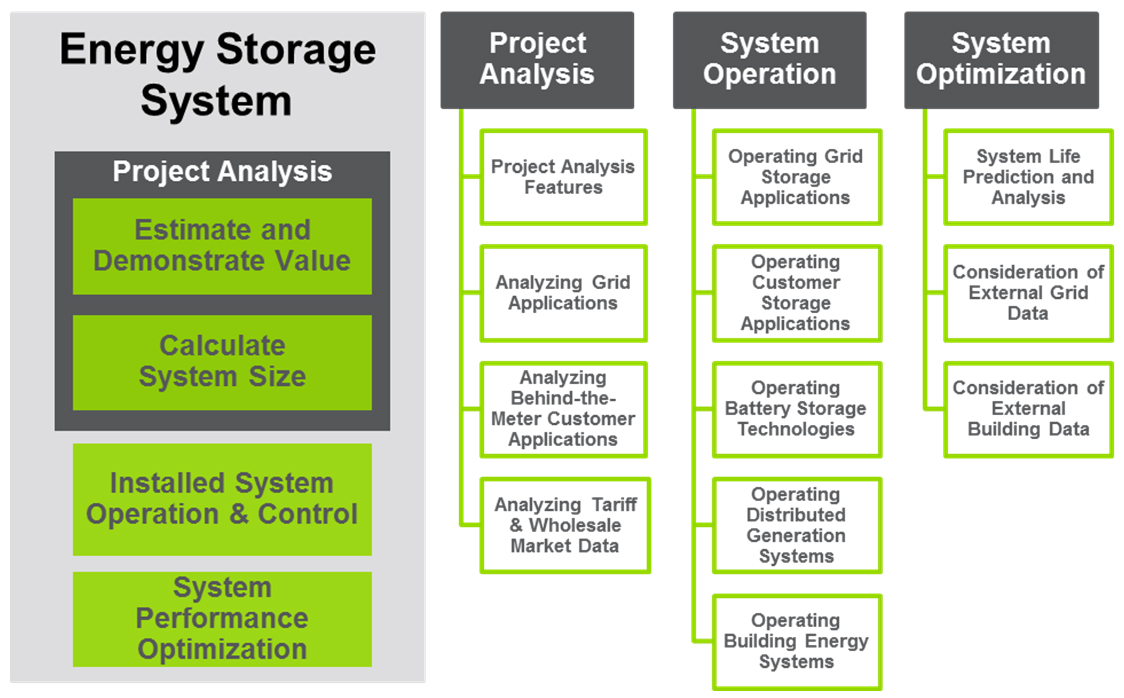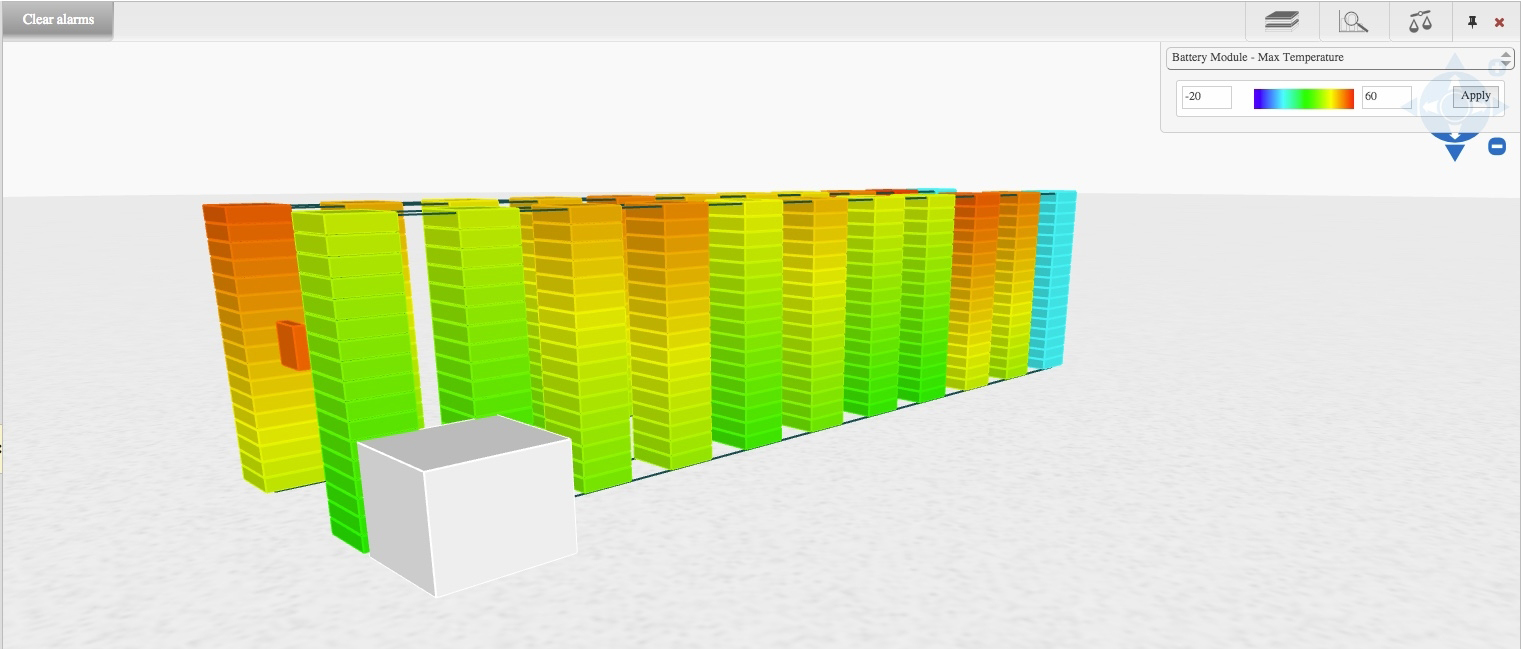Software platforms are emerging as a crucial element in the rapidly expanding energy storage industry. The growing importance of energy storage system (ESS) software is driven by a number of factors as the industry looks to continue recent record-setting growth and overcome several key barriers. Software platforms are primarily responsible for initial project analysis and design, system control and operations, and for optimising system operation over time for maximum value. The following graphic outlines some of the specific functionalities for ESS software. Software and controls will play a central role in the storage industry over the coming years. It is essential for vendors, developers, and other stakeholders to understand the advances being made in software technology and how to capitalise on them.
In addition to these core tasks, ESS software must also ensure safe and reliable operation for as long as possible, a particularly challenging task for battery-based systems where premature degradation is a significant operational and financial risk. Given this range of responsibilities, software is employed throughout the entire lifecycle of a storage project – from design to decommissioning – and has become a critical tool for helping overcome barriers facing the industry. There are two primary barriers to greater energy storage development that software is helping overcome: the high upfront costs for new systems and the lack of customer education and familiarity with the technology.
Enjoy 12 months of exclusive analysis
- Regular insight and analysis of the industry’s biggest developments
- In-depth interviews with the industry’s leading figures
- Annual digital subscription to the PV Tech Power journal
- Discounts on Solar Media’s portfolio of events, in-person and virtual
While these barriers are beginning to come down, the industry remains relatively immature in most of the world. One of the main drivers of future growth will be new software and control platforms that allow ESSs to be virtually aggregated to provide a number of new services for an increasingly diverse range of customers.

Barriers to overcome
The most widely cited barrier inhibiting the widespread development of advanced energy storage is the large upfront investment required for these systems. The range of different energy storage technologies and components makes the task of designing an efficient and cost-effective ESS for multiple different customers and use cases challenging and time-consuming. Leading ESS software vendors are offering modeling and design tools that allow their customers to quickly and accurately design a system that meets their needs at the lowest possible cost. This increase in speed and accuracy of system design has a direct impact on a project’s bottom line and is becoming a competitive advantage for many vendors and developers.
This complex task also requires accurately predicting any degradation and maintenance requirements for a system to ensure the most suitable technology is chosen based on how the project will operate. Factors such as the required depth of discharge, average number of cycles required per year, time between cycles, and operating environment are all important considerations when designing an ESS. Several early energy storage projects failed due to a poor match between the chosen technology and the required operating parameters. Advanced software platforms can avoid these issues and lower the cost to design and build systems to capture the maximum value over the longest possible time period.
Another major barrier to the industry’s growth is the general lack of awareness and familiarity with energy storage and the benefits the technology provides. This lack of education is an issue for numerous stakeholders, including customers, utilities, investors, and government regulators. The innovative software platforms currently available provide vendors with the ability to visualise the performance of a system over time based on data gathered from already operating projects.
Using these platforms, vendors are able to efficiently educate potential customers and other stakeholders on the performance, lifecycle, and benefits of an ESS, including the expected return on investment. This includes the ability to demonstrate the benefits of storage at various locations on the grid, with the aim of providing utilities with the knowledge they need to include storage systems in their resource plans and rate cases. As the installed base of energy storage continues to grow, the accuracy and functionality of these modeling platforms will also increase. This in turn will lead to better educated customers and a greater level of trust in the technology, resulting in lower costs as financiers become more confident investing in projects.

Software driving a rapidly evolving industry
The global energy storage industry has experienced exponential growth over the past three years. This trend is expected to continue over the coming years as costs fall, while the capabilities and functionality of these systems increase. Some of the most impactful trends expected in this market over the next several years are driven directly by advances made in ESS software.
Perhaps most notably, the aggregation of distributed ESSs through software is a game-changing capability than can have major implications for the future of this industry. The aggregation of ESSs represents one form of virtual power plant (VPP), a platform which greatly enhances overall value by utilising a network of systems, compared to a single system on its own. Software platforms are the key enabling technology for this complex aggregation, which requires both centralised management and coordination, as well as local controls embedded in each system. By aggregating a network of distributed ESSs, a VPP can coordinate charging/discharging patterns to provide valuable services to grid operators such as reduced peak demand in select areas, frequency and voltage regulation, and renewable energy ramp rate management. With the right market structures in place, these services can provide new sources of revenue for distributed ESSs by helping grid operators maintain stability and defer or avoid new infrastructure investments and system upgrades.
Software providing this type of aggregation must balance the differing and often competing interests of customers and the grid while ensuring the maximum possible revenue is generated from each individual system. Although this type of operation requires more advanced and expensive software, the ability to open revenue streams outside of just helping customers save money is expected to lead to lower costs for customers and new deployments. Aggregation is becoming a key focus for software vendors – not only to use for their own ESSs, but also as a service they can provide to utilities and the growing range of energy storage customers.
Traditionally, there have been only a select number of potential customers for advanced ESSs. These were primarily utilities with specific needs and off-grid customers that relied on renewables or other forms of distributed generation. However, the falling costs for ESSs, along with the enhanced functionality enabled by software, have resulted in a broadening customer base with diverse needs. Customers including utilities, renewable energy project developers, ESS and project developers, commercial & industrial building owners, and energy management companies are now procuring energy storage to provide a variety of services. This range of customers requires advanced software capable of properly designing systems and tailoring operations to each individual customer for the maximum benefit at the lowest possible cost.
Software is expected to play an increasingly important role in the energy storage industry as power grids around the world transition to a system more reliant on variable generation and distributed energy resources. Energy storage is viewed as a key technological building block for the grid of the future; however, without sophisticated platforms for design and control, these systems have limited value. The ability to optimally and cost-effectively design and control an ESS through advanced software is bringing down many of the barriers that have held back the development of energy storage to date. As the industry continues to mature, software’s significance will expand by allowing for communication and coordination between systems distributed throughout the grid, providing the essential links for a clean and resilient power system.

